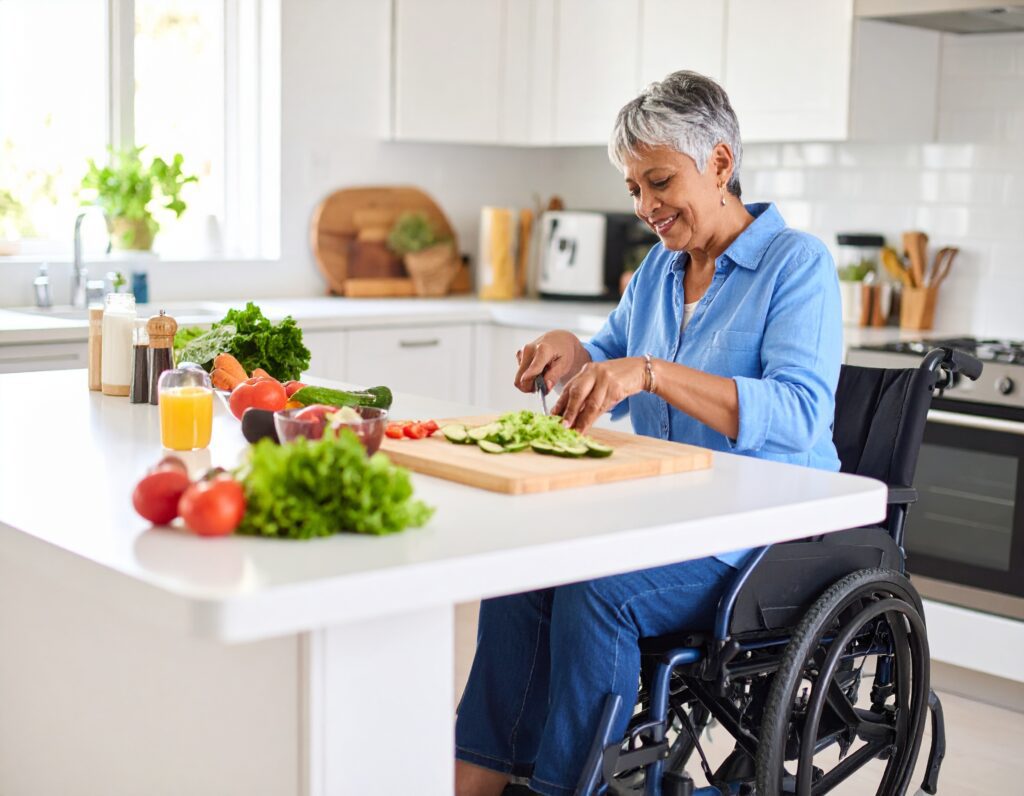As more adults over 55 embrace aging in place, remaining in their own homes safely, comfortably, and independently, the demand for smart, stylish design solutions continues to grow. Nearly 77% of adults 50 and older say they want to remain in their homes as they age (source: 2023 Home and Community Preferences Survey). But too often, aging-in-place design gets reduced to clinical features that strip homes of warmth, character, and beauty.
The truth? You don’t have to sacrifice style for safety. We spoke with Melissa Campbell, ASID, CAPS, RID, a Licensed Interior Designer based in Montgomery, Texas, who has spent the past 16 years helping homeowners create timeless, functional spaces tailored to their needs. As a professional member of ASID and a CAPS-certified designer, Melissa specializes in balancing accessibility, aesthetics, and comfort, proving that aging in place can be both safe and beautiful.
“Integrating accessible features into the overall home allows for safety and ease of use for all users, including guests”
Overlooked Design Mistakes That Create Safety Hazards
Many homeowners start with the bathroom when thinking about aging in place. While that’s important, Melissa warns that focusing only on the obvious can leave dangerous gaps in safety.
“Many people recognize that a bathtub or shower may need to be modified for long-term ease of use, but thought also needs to be given to door openings being wide enough for a walker or wheelchair,” she explains. “This can easily be addressed during new construction, but there are also simple changes that can be implemented in remodels for wider doorway access.”
Melissa also points out that flooring transitions often get ignored until a fall happens. “We ideally want to eliminate large saddles or go from a smooth surface to a thick carpet. Polished tile in wet areas, like near the dishwasher or outside the tub, should be replaced with slip-resistant material with a higher Dynamic Coefficient of Friction (DCOF).”
The stakes are high. Falls remain the leading cause of injury for older adults, with one in four Americans aged 65+ falling each year (source: CDC).
How Melissa Balances Safety, Accessibility, and Beautiful Design
Melissa’s approach always starts with intentional, universal design, creating homes that serve people of all ages and abilities without sacrificing comfort or beauty.
“Great design begins with the end goal in mind,” Melissa says. “I try to incorporate universal design features into every home, regardless of age and ability. Integrating accessible features into the overall home allows for safety and ease of use for all users, including guests.”
Her practical and elegant solutions include zero-threshold showers that work as well for a teenager with a sports injury as for an aging adult. Toilet paper holders that double as grab bars blend seamlessly with any décor, and thoughtful appliance placement ensures that counters, ovens, and storage are easily accessible without limiting material choices or design style.

Simple Upgrades Homeowners Can Make Right Now
For those looking to make their homes more aging-friendly, Melissa recommends a few immediate, high-impact changes:
Replace round doorknobs, sink faucets, and shower controls with lever-style handles. “They provide an easier grip for arthritic hands.”
Install grab bars in bathrooms, both in showers and near toilets, to provide additional support and balance.
Upgrade to comfort-height toilets for easier sitting and standing. Many homeowners also add bidet functions for added hygiene and convenience.
These simple, affordable upgrades can often be completed in a weekend and make a noticeable difference in daily comfort and independence.
The Exciting Innovations Transforming Aging-in-Place Design
As the market grows, product innovation is keeping pace — offering new solutions that combine function and style.
One product Melissa is particularly excited about is Kwikset’s illuminated door handle. “Kwikset released a door handle with integrated LED lighting that is activated via motion sensor,” she explains. “I love that this (Halifax) collection allows for safe passage down a hallway or to the bathroom in the middle of the night.”
Kitchen design is evolving too. “I’m excited to see more homeowners accepting induction technology, since these cooktops do not off-gas and do not have an open flame. Induction further prevents burns since the surface only heats where it is in contact with a ferromagnetic material.”
These innovations allow homeowners to maintain both their independence and their personal design aesthetic while adding modern safety features.
Aging in Place Can Be Beautiful, If You Design It Right
At its core, aging in place is about preserving independence and quality of life. As Melissa Campbell shows, with the right design approach, seniors can enjoy homes that are both safe and stylish — with no need to compromise.
For homeowners planning ahead or considering modifications, Melissa’s advice is clear: start early, work with a designer who understands universal design, and create a home that adapts with you over time while still reflecting your personal style.
About the Expert:

Melissa Campbell is a Licensed Interior Designer in the Montgomery, Texas area. She is a professional member of ASID, CAPS certified, and has enjoyed helping homeowners design functional, beautiful homes over the past 16 years. Her focus is on timeless, quality interiors tailored to each client’s unique wants, needs, and lifestyle.
website: www.discerningdesigns.net
Sources :
Home and Community Preferences Survey, 2023
CDC Falls Facts for Older Adults, 2023




